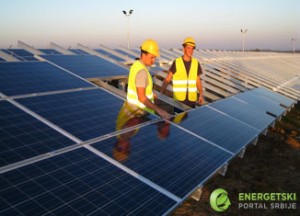
The UK could treble the amount of solar power on the system without pushing up costs, a study suggests.
Concerns have been raised about the costs of integrating intermittent renewables, such as solar panels which only generate electricity when the sun is shining, into the UK power market.
But analysis for the industry shows that the cost of handling variability and providing “back-up” to ensure the lights stay on adds just £1.30 per megawatt hour (MWh) of power provided – less than 2% of the costs of solar of around £80 per MWh.
The analysis by Aurora Energy Research also finds that it would be relatively cheap to more than treble the amount of solar on the system from 11GW today to 40GW (gigawatts) by 2030, which would provide 10% of the UK’s power.
A central forecast for integrating the technology and providing back-up power adds £6.80/ MWh, an amount likely to be “dwarfed” by overall falls in the cost of solar power.
With a large amount of wind power also on the system, the figure would fall to £5.10/MWh, and if new nuclear – which is hard to integrate as it is inflexible – does not go ahead, it is even cheaper, at £3.10/MWh.
The cheapest option involves 40GW of solar and large-scale battery storage, which work well together in a “smart” system to store excess power generated from sunshine and provide it when demand peaks in the late afternoon and evening.
Combining solar and batteries, which cuts the need for back-up and integrates battery technology efficiently, could even reduce costs to such an extent it results in a net benefit of £3.70/MWh.
The Solar Trade Association (STA) said the analysis supports expectations that solar could be the lowest-cost way of generating electricity by the 2020s and called on the Government to “seize the agenda” to drive clean energy forward.
Dr Benjamin Irons, a director at Aurora Energy Research and lead author of the report, said: “Recent spectacular technological progress in renewable power generation puts the promise of cheap, low carbon power within reach.
“The challenge of integrating large volumes of renewables into the network in a way that provides reliable power to consumers and an attractive market for complementary generation technologies is the ‘last frontier’ in delivering the power system of tomorrow.
“Our analysis shows that such integration is possible and surprisingly affordable: the UK could more than triple the amount of solar power on the system by 2030, with associated costs of integration and backup so low as to be dwarfed by the enormous cost savings anticipated from falling solar prices over the same period.”
He added: “Battery storage aids integration even further, as does a diverse renewable portfolio including wind.”
Paul Barwell, chief executive of the STA, said the report showed that solar “sits right at the heart of the smart power agenda, which overall could save consumers billions every year”.
He added:”If we seize this agenda now, the UK can own the clean energy future.”
Source: money.aol.co.uk

